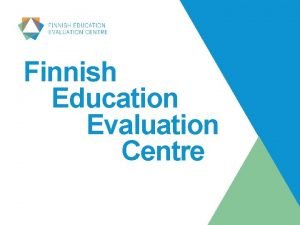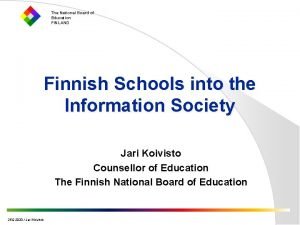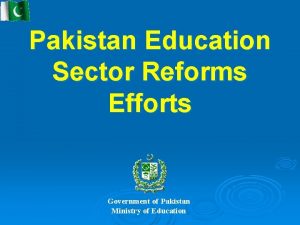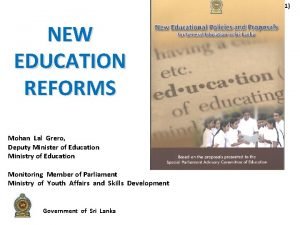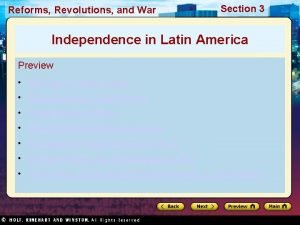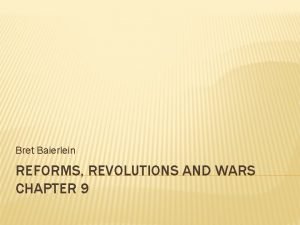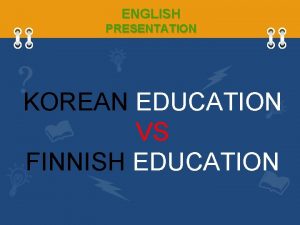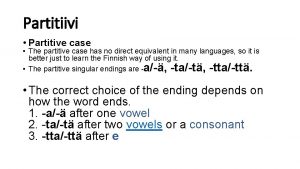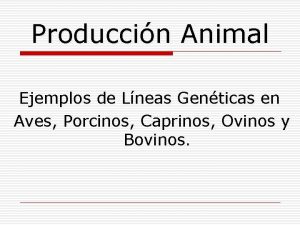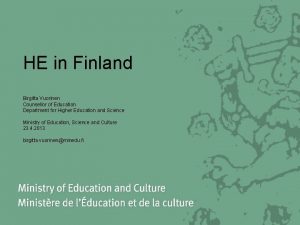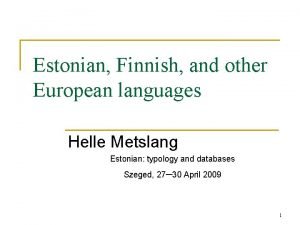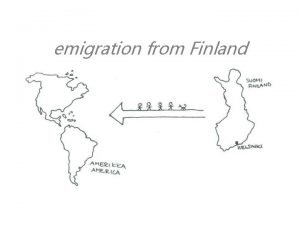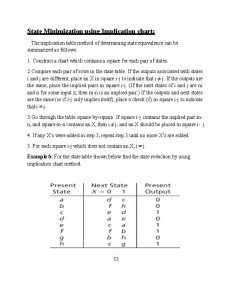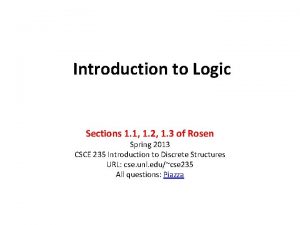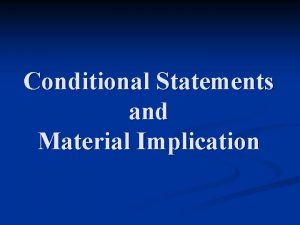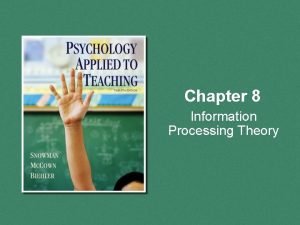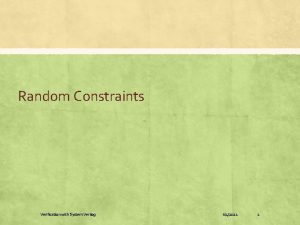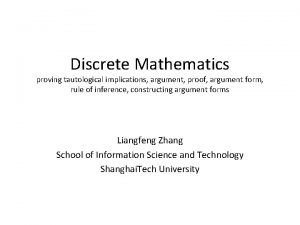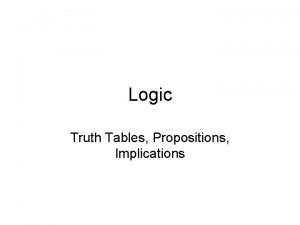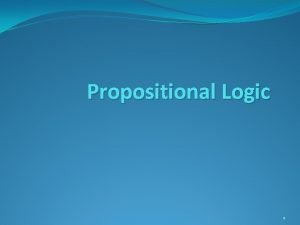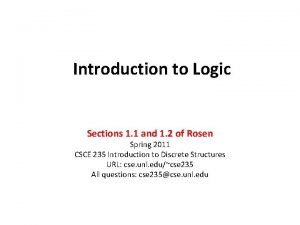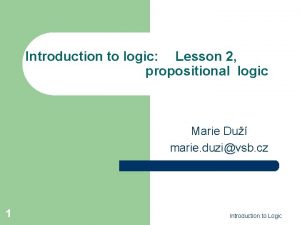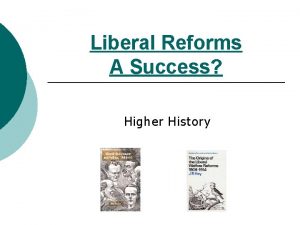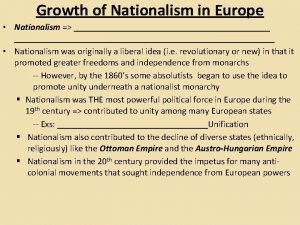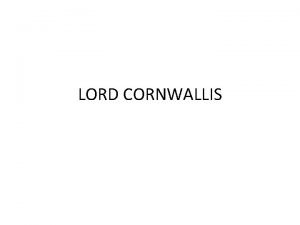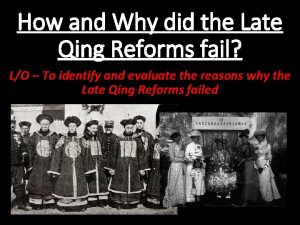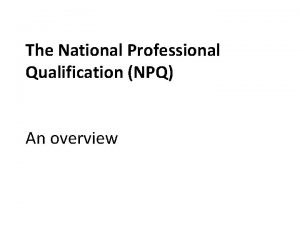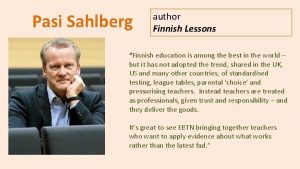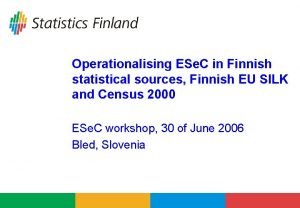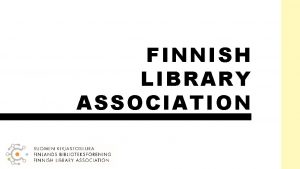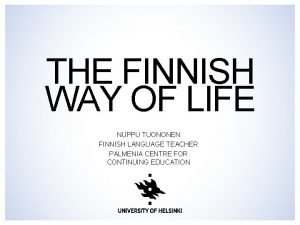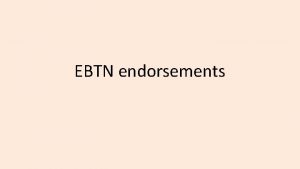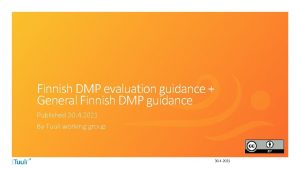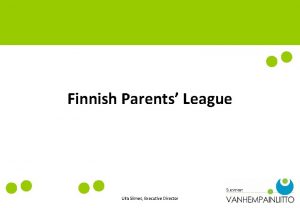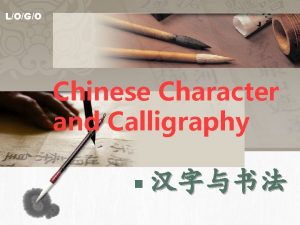Chinese education reforms and implication for Finnish education

















































- Slides: 49

Chinese education reforms and implication for Finnish education export CEREC Lecture Series 8 February 2012 Professor: Seppo Hölttä Adjunct Professor: Yuzhuo Cai Chinese Education Research & Exchange Centre, HEG School of Management, University of Tampere

Main topics Structure of Chinese education system National Higher Education Entrance Examination (gaokao) and its impact on basic education Reforms in Chinese education Reform and development plan 2010 -2020 Internationalisation of education Implications for Finland

Structure of Chinese education system

Chinese Education System Universities or research institutes Doctorate study 3 y Universities or research institutes Master’s study 3 y Universities Bachelor 4 y Senior middle schools 3 y Vocational Colleges / Polytechnics Dazhuan (Associate Degree) 3 y Vocational schools 2 -3 y Junior middle schools 3 y Compulsory Primary schools 6 y

Major statistics (MOE, 2010) Level of education (Excl. adult education ) Inst. Teachers Students Higher Education 2 358 1 343 127 23 856 345 Senior Secondary 14 058 1 518 194 24 273 351 Secondary Vocational 8 735 788 434 20 193 663 Junior Secondary 54 823 3 523 382 52 759 127 Primary Education 257 410 5 617 091 99 407 043 Special Education 1 706 39 650 425 613

National Higher Education Entrance Examination

gaoka 0 The National Higher Education Entrance Examination Usually taken by students in their last year of senior secondary school Although no age restriction since 2001 Offered once a year, takes two days Determine the fate of more than 10 million Chinese students every year

Nervous parents waiting outside

Impact on basic education Students study very hard already in primary schools Severe competition for access to better junior secondary schools and senior secondary schools Students are overloaded Students are trained for exams but lack of creativity

Chinese tradition in education “while every individual is affected by the quickening flow of world events, he is still strongly influenced by the way of living and thinking in his own nation and culture” Nakamura (1964, p. 3) A good scholar can be an official and he who excels in study can follow an official career (a Confucian slogan for education)

Reforms in Chinese education

Education reforms in the P. R. China 1950 s Soviet Model Cultural revolution 1966 -1976 1978, the Third Plenary Session of the 11 th Central Committee of the CCP held in December 1978 1985, the First National Education Conference, Decision on Reforming the Education System 1993, the Outline for Education Reform and Development in China 2010, the Outline of National Plan for Medium and Longterm Education Reform and Development (2010 -2020)

1993 onward reforms “It was not until the 1990 s, when the Outline for Reform was announced, that major reforms were massively implemented” (Yang, 2000, p. 32)

Key policies after 1993 1993 Teachers’ Law 1995 Education Law 1995 Interim Provisions on Chinese-Foreign Cooperation in Running Schools 1995 The Various Opinions on Deepening Higher Education System 1996 Vocational Education Law 1996 Temporary Provisions for Charging Tuition Fees in Higher Education Institutions 1998 Higher Education Law 1998 Action Plan for Invigorating Education for the 21 st century (1998 -2002) 1999 Decision on Deepening of Education Reform and Advancement of Qualification –Oriented Education in an all Encompassing Manner 2002 Private Education Law 2003 Regulations on Chinese-foreign Cooperation in Running Schools 2004 Action Plan for Invigorating Education (2003 -2007)

Reform Strategies “to introduce market forces to liberate education, create impetus for change, and encourage competition for improvement”, “to use legislation to regulate new social relationships, practices and behaviour arising from the first strategy” (Law, 2002: 579).

Dramatic Enrolment Expansion (Unit: 1000 students) new students enrolled 80 19 82 19 84 19 86 19 88 19 90 19 92 19 94 19 96 19 98 20 00 20 02 20 04 20 06 20 08 19 19 78 7 000 6 000 5 000 4 000 3 000 2 000 1 000 0

Gross Enrolment Ratios 1978 -2007 Gross enrolment ratio (%) 25 20 15 10 5 19 78 19 80 19 82 19 84 19 86 19 88 19 90 19 92 19 94 19 96 19 98 20 00 20 02 20 04 20 06 0

Privatisation in educational provision Recognising the fact that the state alone can never meet growing educational needs, the Chinese government has deliberately devolved responsibilities to other non-state sectors to engage in educational provision and development. Put the governance of private higher education on a more solid legal footing. By 2008, 640 private universities and colleges (with degree-granting status), enrolment in the sector accounting for 20 % of total higher education enrolment.

Financial diversification The shift of financial responsibilities from the State to nonstate sectors through privatisation of higher education Further transfer of financial responsibility to individuals and families; by 1997, all university students had to pay tuition fees. Universities have been encouraged to engage in business and market-like activities to generate more incomes, under the financial constraints aggravated by dramatic enrolment expansion since 1999.

Decentralisation of administration While the State exercises macro control through legislation, funding and planning, individual institutions are granted much more autonomy and decision-making power in education matters. Devolution of power gradually from the central government to provincial governments. Many colleges and universities which had originally been under administration of ministries were either transferred to the Ministry of Education, or the provincial educational authorities.

Numbers of mergers 1990 -2005

Building key and world class universities “ 211” project, since 1995 In the 21 st century, develop approximate 100 key universities with intensive government funding. 112 “ 985” project, since 5 (May), 1998 To establish a number of first-rank and internationally recognised universities 34

The Outline of National Plan for Medium and Long-term Education Reform and Development (20102020)

Problems identified by Education 2020 Concept of education and teaching contents and methodology are relatively outdated. Schoolwork burdens on primary and middle school students are too heavy. The promotion of quality education is arrested. Students are weak in their adaptability to society. Innovative, practical and versatile professionals are in acute shortage. Schools lack vitality in their operations. The structure and geographical distribution of education resources are not balanced (disparity between poor and developed regions, between urban and rural areas). Financial sources cannot keep up with the increasing education demands.

Why the reform? To solve all the mentioned problems. To respond to the needs arising from the transformation labour-intensive economy to knowledge economy/innovation system. To increase international competitiveness.

Goals Goal One: Universal education Goal Two: Equitable education for all Goal Three: High-quality education Goal Four: Life-long education system Goal Five: Dynamic educational system

Major reforms To increase educational resources up to 4% GDP To reinforce the support for the poor regions in the middle and west China To enhance teachers’ training To give vocational education more priority To strengthen interactions between (vocational and higher) education and industry To improve the quality of education, research and service, To build world-class universities

Major reforms To support the development of private education To reform gaokao in the effort to terminate the practice that a single round of examinations decides the destiny of a student, to orient the education towards cultivation of innovative personnel. To further separate government functions from school management To promote and upgrade international exchanges and cooperation To introduce high quality education resources abroad

Internationalisation of higher education

Student mobility (outward)

Top 5 Destinations for Chinese Students studying abroad 2004 – 2006 (UNESCO/OECD )

Students’ planed study destinations (INTO, 2009)


Student mobility (inward)

Entrants of international students in 2009 South North Oceania, 1, 06% America, 1, 65% America, 9, 17% Europe, 17, 86% Asia, 63, 52% Africa, 6, 75%

International research and teaching English text books English or bilingual teaching Programmes leading to international professional qualifications Participating in international research projects Opening foreign researchers to Chinese national projects

Sino-Foreign cooperation in running schools Foreign education institutions can engage in education provision in China in cooperation with local educational institutions High-quality foreign education resources are expected Fast growing between 1995 -2005 By June 2004, 754 joint programmes in China, of which 169 are qualified to award overseas degrees hosting 51, 893 students

Countries of origin of overseas partnership institutions the UK, 5, 5% Others, 9, 8% France, 6, 7% Canada, 8, 5% Hong Kong, 13, 4% Australia, 29, 3% the USA, 26, 8%

Challenges Ideological conflicts Low-quality foreign education resources introduced to China Unbalanced development Brain drain Lack of degree programmes taught in English Lagging behind legislative and administrative environment

Future tendencies More highly talented high school graduates go to study abroad Influx of returned overseas students New area of Sino-Foreign joint education provision in China Expansion of Chinese education export

Implications for Finnish education export

A fit between both countries' strategies? The cooperation between China and Finland can go well only when there is a fit between both countries’ strategies on internationalisation of higher education How can Finnish strategies reconcile the Chinese expectations?

Finnish objectives and Chinese needs Finland Export education High quality of education The demand in the targeting market is growing China Meeting local educational demands Improving the quality of skilled labour Increasing international preparation and competitiveness

Is there a match? Yes, but only when the Finnish higher education is correctly perceived and appreciated by the Chinese stakeholders

General Challenge to be solved Information asymmetry between the consumers and producers Students and other clients use classification or rankings and the general reputation of universities in their decision making. Existing rankings are based mainly on research output, not on educational quality Finnish HEIs are not at the top, most of them totally invisible How to show the quality to potential students and their families?

Need to follow closely relevant policy processes Education policy Other sectoral policies, e. g. public administration, innovation policy, industrial development policy Main instruments Research Stakeholder coopeartion

Attractiveness of Finnish higher education to China Asymmetry between students and universities exists: quality of education or programmes We need to emphasise also the other education related qualities of Finnish society Finland is one of the global leaders in developing information society and innovation systems. Finland has won top positions in a number of international comparisons, such as PISA study, education system and quality of life. Finland as a traditional welfare state attaches an importance to the balance between education as a public good and as an industry.

Attractiveness of Finnish higher education to China Finland as country being successively controlled by Sweden and Russia for hundreds of years understands the need of preserving the national tradition and culture. Finland has the highly developed quality culture in higher education as well as the most advanced quality assurance system in the world. Finnish government has a strong role in higher education development that is comparable to the Chinese system. The curricula and training in Finnish higher education has a close link to labour market. All international programmes in Finnish higher education are taught in English.

Thanks for your attention! You are welcome with questions!
 Finecc
Finecc National board of education finland
National board of education finland Education sector reforms in pakistan
Education sector reforms in pakistan Www.mohanscience.lk
Www.mohanscience.lk Primary 3 malay worksheets
Primary 3 malay worksheets Reforms revolutions and war answer key
Reforms revolutions and war answer key Wars revolutions and reforms
Wars revolutions and reforms Finnish cultural foundation grants
Finnish cultural foundation grants What nationality is finnish
What nationality is finnish Sfs finland
Sfs finland Finland oats
Finland oats Finnish fruit plait
Finnish fruit plait Finnish korean war
Finnish korean war Partitive case
Partitive case Finnish multinational company
Finnish multinational company Olavi korolainen
Olavi korolainen Finnish information security cluster
Finnish information security cluster Finnish landrace ó finnsheep
Finnish landrace ó finnsheep Birgitta vuorinen
Birgitta vuorinen Finnish agglutination
Finnish agglutination Countryside in finland
Countryside in finland Kerava.inschool
Kerava.inschool Implications table
Implications table Implication elimination
Implication elimination Symbolic logic rules
Symbolic logic rules Logical connectives symbols
Logical connectives symbols Example of proposition in math
Example of proposition in math Material implication examples
Material implication examples Teaching implication of the information process
Teaching implication of the information process Systemverilog implication constraint
Systemverilog implication constraint Tautological implications in discrete mathematics
Tautological implications in discrete mathematics Truth table of implication
Truth table of implication Disjunction proposition
Disjunction proposition Mathematical system
Mathematical system Proposition in mathematics
Proposition in mathematics Inverse implication
Inverse implication Implication for practice
Implication for practice Tanzimat reforms definition
Tanzimat reforms definition Nuclear membrane reforms
Nuclear membrane reforms It is the peaceful crusade or campaign for reforms
It is the peaceful crusade or campaign for reforms Higher history essay example
Higher history essay example Tanzimat reforms definition
Tanzimat reforms definition What economic reforms did the populist party call for?
What economic reforms did the populist party call for? Introduction of ncf 2005
Introduction of ncf 2005 Administrative reforms of cornwallis
Administrative reforms of cornwallis Julius caesar reforms
Julius caesar reforms Late qing reform
Late qing reform Reforms in the antebellum period
Reforms in the antebellum period Phrenology apush
Phrenology apush Npqml project example
Npqml project example
